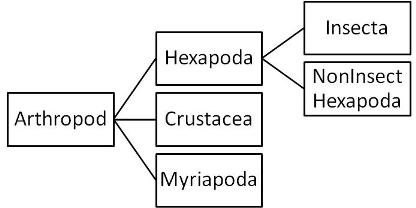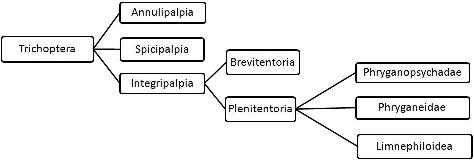Classification
| Domain: |
Eukarya |
Members of Eukarya have cells with a true nuclei |
| Kingdom: |
Animalia |
Animals are heterotrophic, multi-cellular, lack a cell wall and generally reproduce sexually |
| Phylum: |
Arthropoda |
Arthropods have a tough outer skeleton, segmented bodies, and jointed legs |
| Superclass: |
Hexapoda |
Hexapods have six legs, two antennae and are mostly terrestrial |
| Class: |
Insecta |
Insects are winged Hexapods with bodies divided into head, thorax and abdomen regions |
| Order: |
Trichoptera |
Trichoptera larvae live in water and most make protective cases from organic and inorganic bits |
| Family: |
Phryganeidae |
Phryganeidae are known as the Large Caddisflies. They are 14-25 mm |
[Click
HERE to see a dichotomous key differentiating within the
Phryganeidae family.]
This broad phylogenetic tree shows how Trichopera is related to other classes and superclasses among the Arthropod phylum.
This phylogenetic tree is more specific, but not all encompassing. The three categories branching off of Tricoptera are divisions based on the type of shelter that the organism makes (Annulipalpia- retreat makers; Spicipalpia-cocoon makers; Intergripalpia- tube case-makers). These groups are then divided once more before the family Phryganeidae is reached. The tree also shows relationships between Phryganeidae and other families. All of these distinctions are based mainly upon morphological evidence.

